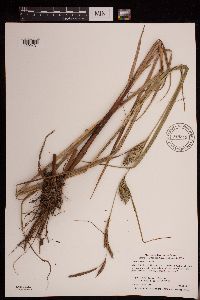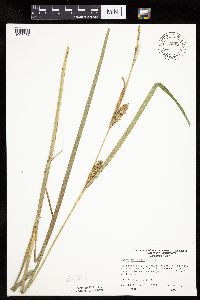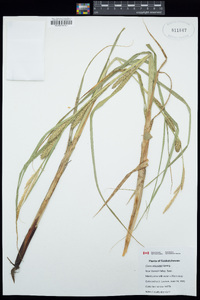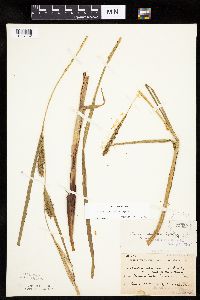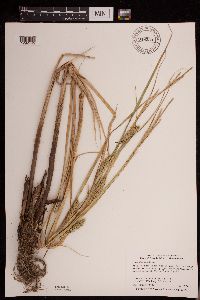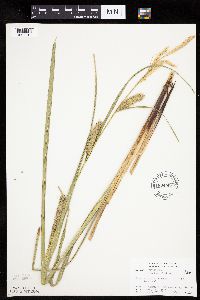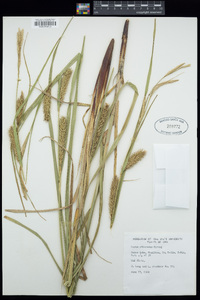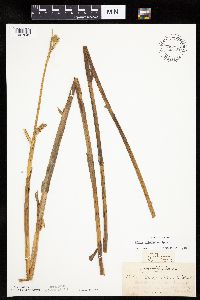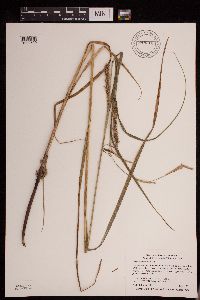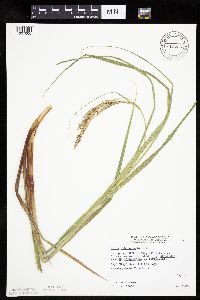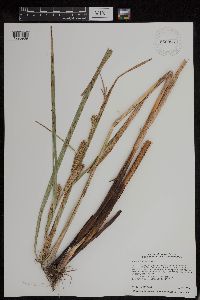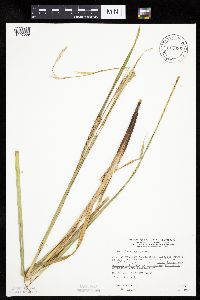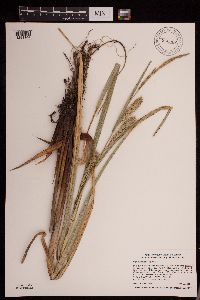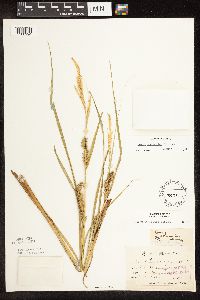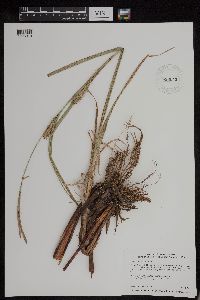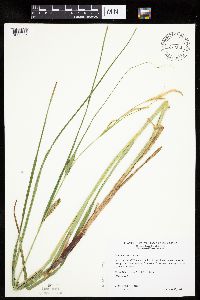Carex atherodes
|
|
|
|
Family: Cyperaceae
Wheat Sedge, more...awned sedge, slough sedge
[Carex mirata, moreCarex mirata var. minor Dewey, Carex orthostachys C.A.Mey., Carex trichocarpa var. deweyi L.H.Bailey, Carex trichocarpa var. imberbis , Carex trichocarpa var. turbinata Dewey] |
Culms hollow, ± spongy near base, trigonous in cross section, 35-125 cm; vegetative culms hollow, flattened when pressed, taller than fertile culms. Leaves: basal sheaths reddish purple, inner bands fibrillose with age; sheaths with apex of inner band pale brown to dull reddish purple, pubescent or scabrous, at least apically, rarely glabrous; ligules (6-)11-45 mm; blades 3-10 mm wide, usually sparsely to moderately long-pubescent, finely papillose abaxially, glabrous adaxially. Inflorescences 12-60 cm; spikes erect or ascending; proximal 2-5 spikes pistillate; terminal (1-)2-6 spikes staminate. Pistillate scales lanceolate to narrowly ovate, apex acute, conspicuously scabrous-awned, glabrous or scabrous near midrib. Staminate scales lanceolate to narrowly ovate, apex obtuse to acuminate, scabrous-awned, glabrous or, rarely, sparsely pubescent. Perigynia 12-21-veined, (6.5-)7-12 × 1.8-3.8 mm, glabrous; beak 2.1-4 mm, glabrous (rarely few spreading hairs on main veins), teeth spreading to outcurved, (1.2-)1.5-3 mm. Fruiting Jun-Aug. Marshes, wet prairies and meadows, open swamps, wet, open thickets, open stream, pond, and lakeshores, ditches, often in water (to 60-80 cm deep); 50-2800 m; Alta., B.C., Man., N.W.T., Ont., Que., Sask., Yukon; Alaska, Ariz., Calif., Colo., Idaho, Ill., Ind., Iowa, Maine, Mich., Minn., Mo., Mont., Nebr., Nev., N.Mex., N.Y., N.Dak., Ohio, Oreg., Pa., S.Dak., Utah, Vt., Va., Wash., W.Va., Wis., Wyo.; Eurasia. Carex atherodes is a major wetland species in portions of the Midwest and West and becomes increasingly uncommon and local in the eastern portions of its range. It forms large clones and can tolerate deeper water than most Carex. Glabrous forms occur and seem to be more common in the western portion of the range. Carex atherodes rarely hybridizes with C. trichocarpa.
Stems stout, 3-15 dm, arising singly or few together from long, coarse, deep-seated rhizomes, aphyllopodic, the lower sheaths soon breaking and becoming fibrillose; sheaths villous-hirsute all around, or sometimes only toward the ventral summit; blades elongate, 4-10 mm, usually hirsute beneath toward the base, tending to be septate-nodulose; bracts subtending the pistillate spikes sheathless or nearly so, but with elongate blade; spikes several, sessile or inconspicuously short-pedunculate, the lower pistillate and the upper staminate, or the middle one(s) androgynous; staminate spikes 2-6 cm, pale, commonly stramineous, the scales short-awned; pistillate spikes cylindric, 2-10 נ1 cm, the scales stramineous or pale greenish and often largely scarious, narrow, tipped by a rough awn 1-5(-9) mm; perigynia crowded, ascending, pale greenish to stramineous, conspicuously 12-20-ribbed, glabrous, firm, 7-10 mm, lanceolate or lance-ovate, somewhat turgid-inflated below, more flattened toward the well developed beak, this with prominent, often divergent teeth 1.5-2.5(-3) mm; achene trigonous, loosely filling the lower part of the perigynium, continuous with the straight bony style; 2n=74. Marshes and shallow water; circumboreal, extending s. in Amer. to N.Y., W.Va., Mo., Colo., Utah, and Oreg. Gleason, Henry A. & Cronquist, Arthur J. 1991. Manual of vascular plants of northeastern United States and adjacent Canada. lxxv + 910 pp. ©The New York Botanical Garden. All rights reserved. Used by permission. From Flora of Indiana (1940) by Charles C. Deam Rare in northern Indiana in marshes and wet prairie habitats. Reported from Marshall County by Clark but no specimens could be located. ...... Indiana Coefficient of Conservatism: C = 6 Wetland Indicator Status: OBL |
|
|
|











